Size Of Septic For 3 Bedroom House
 Septic Tank Size Requirements
Septic Tank Size Requirements
Septic tank size calculations, size tables & codes
- POST a QUESTION or COMMENT about how to calculate the necessary size of a septic tank
InspectAPedia tolerates no conflicts of interest. We have no relationship with advertisers, products, or services discussed at this website.
Septic tank size specifications & requirements: how big should the septic tank be? Given dimensions, what is the septic tank size or capacity in gallons?
We begin with a table showing the required septic tank capacity or size vs. septic system usage in daily wastewater volume or flow.
Next we provide required septic tank size based on the number of bedrooms in a building - presumably the number of occupants.
Then we explain how to calculate septic tank volume or capacity based on septic tank inside dimensions measured in feet or inches how to convert between cubic feet or cubic inches and gallons of capacity.
We include tables of typical septic tank size dimensions and capacities for concrete septic tanks, plastic or fiberglass septic tanks & steel septic tanks. How to calculate septic tank capacity are explained.
We also provide an ARTICLE INDEX for this topic, or you can try the page top or bottom SEARCH BOX as a quick way to find information you need.
Tables, Codes & Calculations of Required Septic Tank Size
How big does our septic tank need to be? Typically the septic tank volume for a conventional tank and onsite effluent disposal system (such as a drainfield) is estimated at a minimum of 1000 gallons or 1.5 x average total daily wastewater flow.
Here we also discuss the smallest recommended septic tank sizes based on building occupancy or wastewater volume. One should also ask, how does weather affect the necessary septic tank size?
Table of Required Septic Tank Size Based on Daily Waste-Water Volume in Gallons | |
| Average Sewage Wastewater Flow - Gallons Per Day | Minimum Septic Tank Size in Gallons of Effective Capacity Needed (1) |
| 0-500 gpd | 900 gals |
| 601-700 | 1200 |
| 801-900 | 1500 |
| 1001-1240 | 1900 |
| 2001-2500 | 3200 |
| 4501-5000 | 5800 |
Notes to Table Above
- (1) Source: Florida ASHI Seminar, Kissimmee, October 1993, included sheet from Environmental Health Services, March 17, 1992.
- Some intermediate table entries were eliminated but can be recalculated by interpolation
- In most U.S. jurisdictions we surveyed, the minimum permitted tank size for new septic installations is 1000 gallons. Special site considerations may require design by a septic-engineer before local health departments can approve an installation.
- WATER USAGE TABLE provides companion data if you don't already know your daily wastewater volume
- This table is for sizing residential septic tanks.
Separately, COMMERCIAL SEPTIC DESIGN discusses commercial septic tank and drainfield sizing based on wastewater flow estimates. There we also include excerpts from the EPA Design Manual's discussion of how a septic tank size should be determined, including safety factors but balancing design capacity safety with avoiding unnecessarily high costs.
Table of Required Septic Tank Size Based on Number of Bedrooms in a Home
How big does our septic tank need to be based on the number of bedrooms in the home? Some jurisdictions use the number of bedrooms rather than number of occupants or estimated daily wastewater flow to guide homeowners and septic installers in choosing a septic tank size.
|
Septic Tank in Gallons Size Based on Number of Bedrooms | ||
| Number of bedrooms | Minimum Septic Tank Capacity (Gallons) | Minimum Septic Tank Liquid Surface Area (sq.ft.) |
| 0 bedrooms | 750 gal. (2) - obsolete in NYS | |
| 1, 2, or 3 bedrooms | 1,000 gallons | 27 sq.ft. |
| 4 bedrooms | 1,200 gallons | 34 sq.ft. |
| 5 bedrooms | 1,500 gallons | 40 sq.ft. |
| 6 bedrooms | 1,750 gallons | 47 sq.ft. |
Notes to the septic tank sizing table above
An older version of this table permitted 750 gallon septic tanks in some jurisdictions and permitted 1,500 gallon septic tanks for 6-bedroom homes. Some current standards such as New Mexico still permit these smaller septic tank sizes.
Other experts estimate that occupants use between 50 and 100 gallons of water per person per day in a home in the U.S. We can use that guesstimate to compare different septic tank size guidelines.
Also see WATER USAGE TABLE for estimates of typical daily wastewater flow for buildings
The current and somewhat more stringent septic tank size used in the U.S. by New York (Public Health Law 201(1)(1) Section 75-A) standard includes these comments on septic tank sizing:
Tank size requirements for more than six bedrooms shall be calculated by adding 250 gallons and seven square feet of surface area for each additional bedroom.
A garbage grinder shall be considered equivalent to an additional bedroom for determining tank size.
Watch out: 750 gallon septic tanks are smaller than the minimum 1000g size required for new construction in many jurisdictions world-wide.
Source: New York State Department of Health, APPENDIX 75-A WASTEWATER TREATMENT STANDARDS - INDIVIDUAL HOUSEHOLD SYSTEMS, [PDF] New York State Department of Health, 3 February 2010, retrieved 3/1/2010, original source: https://www.health.ny.gov/regulations/nycrr/title_10/part_75/appendix_75-a.htm, updated 12 January 2015 to current table that lumps 1-3 bedrooms together and adds 6-bedroom homes.
Septic Tank Size Requirements May Be Set or Adjusted
by Local or State or Provincial Ordinances, Lift Stations, Weather
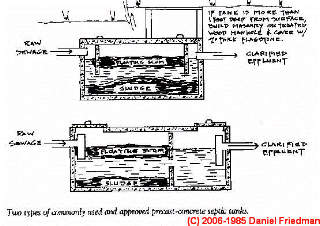 In some jurisdictions, government ordinance may simply specify the minimum allowable septic tank size by:
In some jurisdictions, government ordinance may simply specify the minimum allowable septic tank size by:
- Number of bedrooms (as in our table above).
For example the Alaska state regulation (18 AAC 72) specifies that the minimum septic tank size shall be 1000 gallons for a home with three or fewer bedrooms.
(Most septic design guides presume an occupancy of two people per bedroom, so if your home is more crowded your septic tank size should be increased).
- Septic pumping chambers: use of a septic system pumping chamber: the same example regulations as above state that
If a septic tank incorporates an integral lift station pumping chamber, the required tank size must be increased by 250 gallons [4]
- Local weather temperatures: the same example septic regulation just cited also points out that septic tank sizes need to be considered in view of the climate where they are installed.
In very cold climates such as Alaska and northern Canada, because cold temperatures reduce the anaerobic rate of digestion of sewage solids, the septic tank sizes need to be increased - more size, more net free area, longer septic tank retention times are all needed.
Conversely in warm or hot climates where the level of bacterial action is comparatively greater, septic tank sizes may be a bit smaller.
How to Compute Septic Tank Size and Capacity in Gallons
How do we compute the volume in gallons that a septic tank provides based on simple measurements we can make?
A typical residential septic tank is usually about 4.5 feet wide x 8.0 feet long x 6 feet tall. Your septic tank may be a different size however. Best practice is to find and measure your septic tank for accurate calculations.
Tanks are typically buried 4 inches to 4 feet deep depending on local site conditions, shape, slope, and other factors.
Here is the basic math for computing septic tank capacity (volume) in gallons. Measurements are in feet, taken of inside dimensions of the septic tank.
How to Calculate the Septic Tank Capacity in Gallons | |
| Round Septic Tanks | 3.14 x radius squared x depth (all in feet) = cubic capacity. Cubic capacity x 7.5 = gallons capacity. |
| Rectangular Septic Tanks | Length x Width x Depth in feet x 7.5 = gallons |
| Rectangular Septic Tanks (alternative method 1) | Length x width in inches / 231 = gallons per inch of septic tank depth. Multiply this number by septic tank depth in inches to get gallons |
| Rectangular Septic Tanks (alternative method 2) | Length x Width x Depth in feet / .1337 = gallons |
Notes to the table above
These simple constants and the formula for the volume of a rectangular or round tank will help us convert any septic tank size in cubic feet to gallons of wastewater:
- One gallon = 0.1337 cubic feet.
- One gallon = 231 cubic inches
- 1 cubic foot = 7.48 gallons
- Volume of a rectangle = Length x Width x Depth
- Volume of a cylinder = Pi x radius2 x depth
where radius = half the diameter
- Pi = 3.1416
Examples of Computing Septic Tank Size, Capacity or Volume in Gallons
Example 1: volume of a rectangular septic tank using 0.1337 cubic feet. per gallon
How many gallons of sewage is held in a a 4ft. deep x 5ft. wide x 8 ft. long rectangular septic tank?
The volume in cubic feet of a tank of these tank dimensions is 4ft. x 5ft. x 8ft. = 160 cubic feet.
Using the conversion factor to convert cubic feet to gallons, 160 / .1337 = 1196 - or about a 1200-gallon tank.
One cubic foot of volume can contain 7.481 gallons of liquid. So a second approach to calculating septic tank actual size or capacity in gallons is to multiply the septic tank volume in cubic feet by this constant, which we round up to 7.5 gallons/cubic foot.
Example 2: volume of a rectangular septic tank using 7.5 gallons per cubic foot
How many cubic feet and how many gallons wastewater are held in a rectangular septic tank of typical dimensions of 4.5 ft. wide x 8.0 ft. long x 6 ft. high.
The volume in cubic feet of a tank of these tank dimensions is 4.5 x 8 x 6 = 216 cubic feet.
Since one cubic foot can contain 7.481 gallons, which we round up to 7.5 gallons per cubic foot: 216 x 7.5 = 1620 gallons of septic tank capacity - this is probably nominally a "1500-gallon septic tank".
Note that if the dimensions given by your septic contractor are the external dimensions of a concrete or other thick-walled septic tank tank rather than the internal dimensions then the volume given by this calculation will come up with a septic tank size estimate that is higher than the actual tank capacity - the error is due to failure to allow for the thickness of the septic tank walls.
So for fitting a septic tank into a tight spot, the outer dimensions of the septic tank are important. But for accurate calculation of the capacity of a septic tank you need to use the septic tank internal dimensions.
Example 3: volume of a round septic tank measured in inches & using 231 cu. in. per gal
How many cubic feet and gallons of wastewater are held in a round steel septic tank of dimensions 46 inches in diameter and 73 inches deep?
For this example we're working in inches, not feet.
To calculate the volume of a cylinder, in this case our round septic tank, we use
Septic tank diameter = 46" so its radius is half that or 23"
Septic tank height = 73"
Septic tank volume V = 3.1416 x (23")2 x 73"
Vinches= 121,319 cu. in.
Vgallons = 121,319 cu. in. / 231 cu. in. per gal
Vgallons = 525 gallons
Watch out: this tank will be too small to be acceptable by modern septic tank standards where most codes require a septic tank of at least 1000 gallons. ..
I am working on a project that will utilize septic tanks (several in parallel and series). The WW flows are 20,000 GPD, and influent WW BOD strength is about 450 mg/L and it will be permitted with an effluent strength of 100 mg/L.
The effluent will be disposed of via surface irrigation. I have not been able to find any literature on how to size a septic tank using influent and effluent BOD loadings. All literature I have found is based on number of bedrooms. This OSSF system will serve a Kid's Summer Camp.
Thanks and I look forward to your response. Robby
This question was posted originally at SEPTIC SYSTEM DESIGN BASICS
Right. Yet there has to be an engineering assumption underneath the "number of bedrooms" that translates to "number of occupants" that in turn translates to average daily wastewater flow. That's what we both should look for and report back here.
See for starters WATER QUANTITY USAGE GUIDE https://inspectapedia.com/septic/Water_Quantity_Usage_Tables.php
and be sure to see SEPTIC TANK SIZE https://inspectapedia.com/septic/Septic_Tank_Size_Tables.php
In my OPINION the rule of thumb of 50 to 100 gallons of water per person per day may not be the right match for a kids' summer camp
but it would be really interesting to calculate:
- toilet flushes
- showers
- use of laundry facilities
- dishwashing and cleaning by camp staff
The volume of wastewater in the net free area between the top of sludge and bottom of scum determines the treatment time in the tank as new wastewater flows into the system. That in turn will be an important determinant of BOD measurement results.
For other readers septic BOD refers to Biological Oxygen Demand - the amount of oxygen consumed by and thus required by septic tank bacteria in the breakdown of sewage waste.
Septic Tank Dimensions by Tank Size & Type
Concrete, Plastic / Fiberglass, Steel Septic Tank Dimensions
Table of Concrete Septic Tank Outside Dimensions, Capacity, & Other Data | ||||
| Rectangular Concrete Septic Tank Size (Gallons Capacity) | Tank Length (Inches) | Tank Width (Inches) | Tank Depth (Height) (Inches) | Comments SEPTIC TANKS, CONCRETE |
| 600 gallons | 78 | 56 | 60 | Not legal in many jurisdictions |
| 800 | 96 | 67 | 57 | Not legal in many jurisdictions |
| 1000 heavy duty | 96 | 78 | 61 | |
| 1000 low profile | 120 | 67 | 57 | low profile septic tank |
| 1000 /600 | 145 in. | 68 in. | 61 in. | two compartment tank |
| 1200 | 111 | 78 | 61 | |
| 1250/750 | 162 | 78 | 64 | two compartment tank |
| 1600 | 145 | 78 | 61 | |
| 1600/1400 | 174 | 90 | 73 | two compartment tank |
| 2000 | 162 | 78 | 64 | |
| 2600 | 147 | 90 | 73 | |
| 3000 | 165 | 92 | 76 | |
| 5000 | 204 | 96 | 93 | |
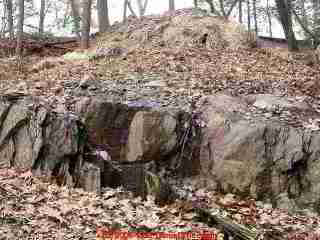
While septic tank sizes are normally given in gallons or liters of wastewater capacity, the actual physical proportions of a septic tank can be important for some considerations.
For example on a very rocky site where excavation to bury a septic tank runs into trouble the installer may decide to choose a shallow but large "flat" septic tank.
In my limited experience with shallow septic tanks they don't work so well and need to be pumped more often. I suspect that the net free area in total volume may meet spec but effluent settlement time may still be too little.
The septic tank under the pile of straw at the top of the septic system failure photo was just such a shallow or "flat" septic tank. Here is a table of some typical septic tank dimensions and other properties.
Plastic or Fiberglass Septic Tank Typical Dimensions | ||||
| Plastic / Fiberglass Septic Tank Size (Gallons Capacity) | Tank Length (Inches) | Tank Width (Inches) | Tank Depth (Height) (Inches) | Comments SEPTIC TANKS, FIBERGLASS / PLASTIC |
| 500 spherical | 64 | 64 | 64 | holding tank or pumping tank, Norwesco |
| 750 linear | 96 | 60 | 51 | sold as single or dual compartment |
| 900 | Snyder Industries. | |||
| 1050 | 126 | 60 | 51 | |
| 1250 | 161 | 60 | 51 | |
| 1500 | 191 | 60 | 51 | |
...
Steel Septic Tank Typical Dimensions | |||
| Steel Septic Tank Size (Gallons Capacity) | Tank Length (Inches) | Tank Width (Inches) | Tank Depth or Height (Inches) |
| 500 gal round | 46 | 46 | 73 |
| 750 gal | 58 | 58 | 73 |
| 1000 | 58 | 58 | 96 |
| 1250 | 58 | 58 | 120 |
| 1500 | 58 | 58 | 144 |
| 2000 | 58 | 58 | 192 |
Notes to the Septic Tank Capacity Table Above
500 gallon septic tanks were usually round; larger tanks may be round or rectangular.
In the U.S. older round cylindrical septic tanks were placed end-wise, that is with a flat end down and a flat cover on top.
Manhole risers: for septic tanks buried at a depth that prevents ready access to and removal of cleanout & inspection covers, a manhole riser with a concrete or steel cover is recommended to permit proper inspection & cleaning. Covers must be of sufficient strength & security to prevent collapse & to prevent a septic tank fall-in hazard.
Concrete & some steel tanks are usually rectangular; plastic & fiberglass septic tanks may be roughly rectangular, oval, or even round spherical. Spherical tanks are usually used for pumping stations not for primary septic tank applications.
Rectangular steel septic tanks are installed in low-profile forms in problem sites in some jurisdictions.
Dimensions & properties taken from surveys of septic tank manufacturers (concrete & other materials).
- "Environmental Health Practitioner Manual: A resource manual for Environmental Health Practitioners working with Aboriginal and Torres Strait Islander Communities", Australia Department of Health, Department of Health GPO Box 9848, Canberra ACT 2601, Australia, retrieved 3/31/14, Original source: https://www.health.gov.au/internet/publications/publishing.nsf/Content/ ohp-enhealth-manual-atsi-cnt-l~ohp-enhealth-manual-atsi-cnt-l-ch2~ohp-enhealth-manual-atsi-cnt-l-ch2.9
- Norwesco, Inc., P. O. Box 439 4365 Steiner Street St. Bonifacius, MN 55375-0439 Tel 800-328-3420 (Customer Service) Fax 800-874-2371 (Customer Service) http://www.NORWESCO.com
- "Septic Tanks", Greer Tank & Welding, Inc., 3117 107th Street Greer Steel in Lakewood Washington Woodworth Industrial Park Lakewood, Washington 98499 Tel: 800-725-8108, email: info@greertank.com, retrieved 3/31/14, original source: http://www.greertank.com/septictanks.html
- "Septic Tank Dimensions & Weights", Huffcutt Concrete, Inc., retrieved 3/31/14, source: http://www.huffcutt.com/tank-weights.php
- "Septic Tanks, Septic Tank Systems - the superior traditional two chamber design", Crystal Sewage Treatment Unit 2 Bolton House Farm York North Yorkshire YO41 5QX United Kingdom Telephone: 01759 369915 Email: info@crystaltanks.com Website: http://www.crystaltanks.com, Tel: 01759-369915, retrieved 3/31/14, original source: http://www.crystaltanks.com/septic_tank_crystal.html
For sewage tanks In the U.K. also see "Code of Practice - Flows & Loads 4 - Sizing Criteria, Treatment Capacity for Small Wastewater Treatment Systems" & "Code of Practice - Guide to the Installation of Small Wastewater Treatment Systems" and
"Code of Practice – Guide to the Desludging of Small Wastewater Treatment Systems" provided by britishwater.co.uk at http://www.britishwater.co.uk/publications/Publications_and_Technical_Guides.aspx
- Snyder Industries, Inc. Corporate Headquarters 4700 Fremont Street (P.O. Box 4583) Lincoln, Nebraska 68504 Phone: 402-467-5221, Tel (Sales): 402-465-1237, Email: sales@snydernet.com
- See details at SEPTIC TANKS, STEEL
Large Capacity Septic System Design Requirements
What can be the appropriate size for a septic tank in a population area of 650 people?
Posted originally at SEPTIC SYSTEM DESIGN BASICS
Mark,
No conventional septic tank would be reasonable for 650 people; the septic tank would have to be millions of gallons, and even then you'd need a thousand acres or so for a conventional drainfield.
For a population of 650 people, you'd need an onsite wastewater sewage treatment plant.
Design, Code & Size Requirements for Two-Compartment Septic Tanks
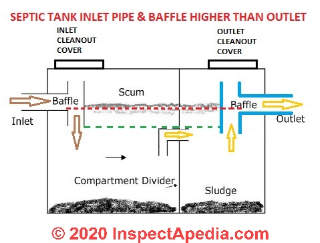 Two compartment septic tanks do a somewhat better job of removing suspended solids from wastewater than single compartment septic tanks, and some jurisdictions, including Alaska (18 AAC 72), require that two compartment septic tanks be used.
Two compartment septic tanks do a somewhat better job of removing suspended solids from wastewater than single compartment septic tanks, and some jurisdictions, including Alaska (18 AAC 72), require that two compartment septic tanks be used.
But we have not found regulations that translate that design difference into different septic tank size requirements.
In some states (Connecticut since January 1991) septic tanks now consist of two compartments in order to do a more effective job, and increasingly other jurisdictions (Alaska, Pennsylvania) require that new and up-graded onsite wastewater disposal systems use two-compartment septic tanks.
Image adapted from Alaska DEC [3] The dashed lines illustrate the liquid level (red) and the difference in elevation (green) between the inlet and outlet septic tank pipe connections.
More about these measurements is
at SEPTIC TANK TEES where we discuss repair procedures and also the problem caused when a septic tank is installed "backwards" with its outlet higher than its inlet.
In a two compartment septic tank the wall separating the two compartments will have an opening that allows liquid effluent to flow into the second compartment, keeping floating scum and settled sludge in the first compartment (mostly).
The septic entire tank, both compartments, will need to become filled with wastewater before any effluent will begin to flow out of the septic tank and into the drainfield or soakaway bed. That happens naturally during normal building plumbing system usage over the course of several days for typical septic tank sizes.
So when you observed about two feet of waste in the septic tank, then left the system unused, you'd expect to find exactly the same amount in the tank weeks later. Only a very slight drop in level might occur, less than an inch - caused by evaporation - because you left the tank open (and dangerous).
Watch out: if your tank is a two compartment type the solids, floating scum and settled sludge are accumulating at the inlet portion of the tank. Inspecting at the final septic tank outlet end will not discover sludge and scum early enough to prevent septic system damage.
Such septic tanks may have a center inspection port which admits tank access at the outlet of the sludge/scum containing compartment. That's where to test in two-compartment septic tanks.
Please see SEPTIC TANK LEVELS of SEWAGE for details about how to interpret abnormal levels of sewage found in the septic tank (too high or too low).
Septic media filter systems also require either two septic tanks or a two compartment tank -
see details at SAND FILTER SEPTIC DESIGNS.
References & authorities for large capacity onsite wastewater treatment plants
- ONSITE WASTEWATER PROGRAM INFORMATION PACKET FOR APPLICANTS (For Septic Tanks with Secondary Treatment) [PDF], Louisiana Department of Health & Hospitals
Office of Public Health Center for Environmental Health Service retrieved 2016/06/26, original source: http://new.dhh.louisiana.gov/assets/oph/Center-EH/sanitarian/ onsitewastewater/AppPackSepticTankSecTreat.pdf - SEPTIC & SEWAGE TREATMENT CODES & REFERENCES
- U.K. OFF-GRID SEPTIC REGULATIONS & SEWAGE SYSTEMS
- U.S. SEPTIC AUTHORITIES & DESIGN SPECIFICATIONS
- SEPTIC & SEWAGE TREATMENT REGULATIONS, OTHER
- SEPTIC INSPECTION & TEST LAWS & PROCEDURES
- SEPTIC TANK DESIGN SPECIFICATIONS - example code specifying septic tank design parameters
- SEPTIC TANK DESIGN STRENGTH SPECS - the required strength of construction of septic tank & cesspool covers, walls, sides, bottoms
Reader Q&A - also see the FAQs series linked-to below
@inspectapedia.com.moderator,
Hhmm, seems someone must've told me I needed a garbage disposal if I added a dishwasher. Likely that was bad info. Since I've never had one, I'm definitely not sure. Good to hear that maybe I don't need one. As far as the other factors, I had hoped the previous testing records I attached below would give the info needed to advise
. I read through all the info posted on page last night and I think it looks to be a sufficient system to support the accessory dwelling. Just wanted your input to make sure I'm interpreting the info correctly. Thanks again for your help. I've been trying to reach the right person at the county environmental Dept.
All week and haven't been able to connect to get answers based on existing records or determine if a new site survey will be needed. Appreciate any interim guidance while I continue to try to reach them.
@Kristen,
I'm unclear why a dishwasher requires a garbage disposer.
I commented earlier on the drainfield size;
Size alone means too little; it's soil perc rate and drainfield age, condition, maintenance history; and perhaps the result of a SEPTIC LOADING & DYE TEST
(try the on page search box)
@inspectapedia.com.moderator, @Kristen,
[Click to enlarge any image]
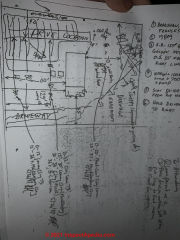
Maybe this will help? Lot 27 info

@inspectapedia.com.moderator,
Yes, that what I'm having trouble discerning. Tank size seems sufficient based on table. Drain field seems huge. At least a 1/4 acre. See image.
@Kristen,
Take a look at the septic tank sizing table above on this page. Remember that's only telling you tank size. The drain field size that you have may be inadequate. That answer depends on the soil percolation rate at your site.
Also, I may need to add a garbage disposal since I plan to have dishwasher installed. In case that needs to be factored in. Thanks in advance for assistance. Kristen
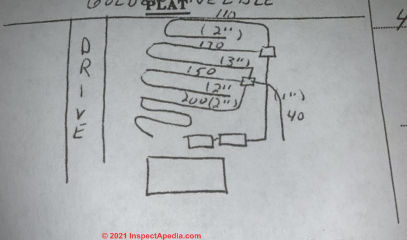
I have a 4 br 2 ba home and am wanting to add an accessory dwelling with a kitchenette and bathroom w/shower. My existing system was installed in late 80s. At that time it was inspected/permitted for a 4 br home with 17-18 fixtures.
Codes have changed since then and I'm having trouble determining if my existing system will be sufficient to support adding the accessory dwelling.
Records from permitting and inspections indicate I have a 1000 gal + 1000 gal sump and 700' + pump. Assuming the county will consider the accessory dwelling as a 5th bedroom, is my existing system sufficient? I'm in NC if that helps. Class II-III soil.
@Mike,
Please take a look at
COMMERCIAL SEPTIC DESIGN
https://inspectapedia.com/septic/Commercial_Septics.php
And don't hesitate to post further comments or questions as needed
Hi, I'm from South Africa.
Got a factory with 70 staff and 10 toilets and 5 basins. What size would my septic tank have to be? Regards Mike
@Anonymous,
See the septic tank sizing table above on this page that uses number of bedrooms
rv trailer 2 adults and one child
@Frank,
Please see
https://inspectapedia.com/septic/Commercial_Septics.php
COMMERCIAL SEPTIC DESIGN
Whats the size of septic tank needed for 250 persons in and out...?
@Christy,
You will want to update your daily Wastewater flow based on the anticipated usage of your bathrooms and then look at the septic tank size tables given above on this page
what's the size of a septic tank needed for a 8 bathrooms attached hospital
@Haley,
The smallest residential septic tank size permitted by building officials in most communities is 1000 gallons - but your local building or health or plumbing department is, of course, the final legal authority to answer that question.
Septic tanks do not "overflow" and there is no "overflow size" but I suspect you meant to refer to the require soil absorption system or drainfield or soakaway into which clarified effluent, leaving the septic tank, is absorbed and treated.
There is no single "right answer" to the minimum drainfield size as the size depends on both the average daily wastewater flow volume AND on the soil's ability to absorb effluent - which varies enormously by location.
See those details at SEPTIC DRAINFIELD SIZE https://inspectapedia.com/septic/Septic-Drainfield-Size.php
And don't hesitate to post follow-up questions if any of that is unclear
Hi, what is the standard size for a septic tank & overflow for sep up system for a maximum of two person thanks?
@Jennifer, no one can give a confident, correct answer to your question without more information, for example, soil percolation rate, drainfield size, tank size; surely you had a septic engineer design the system based on loading volumes and site characteristics?
@Douglas, @timothy mathews,
@Jennifer,
Above on this page in the table titled
Table of Required Septic Tank Size Based on Daily Waste-Water Volume in Gallons
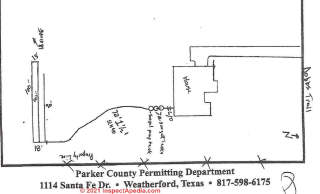 you will see that a 1000 gallon capacity septic tank can support 1900 gallons of daily wastewater flow.
you will see that a 1000 gallon capacity septic tank can support 1900 gallons of daily wastewater flow.
In the alternative table
Septic Tank in Gallons Size Based on Number of Bedrooms
you will see that a 4 bedroom house wants a 1,200 gallon septic tank or larger.
I am treating your 3rd 500 gallon tank as a pumping chamber so am not counting it in capacity - but that' s a question to review with your septic engineer.
The concept is that we need a sufficient septic tank volume to allow sufficient settlement time that we don't push solids out into the drainfield (destroying it).
I am buying a home with 2-500 gallons and 1-500 gallon pump tank. [Septic system layout sketch shown above]
The house size is 2543, 4 bedrooms, 2 bathrooms and it also has a seperate appartment that is 702 sq ft, 1 bedroom, kitchen, 1 bathroom. Is this septic system big enough?
@Ferdinand,
The septic tank size won't get us to a working septic system to support 100 people.
Take a look at
COMMERCIAL SEPTIC DESIGN https://inspectapedia.com/septic/Commercial_Septics.php
and at
SEWAGE TREATMENT PLANTS, RESIDENTIAL https://inspectapedia.com/septic/Packaged-Cluster-Septic-Systems.php
You'll see that the real rub is how to dispose of the volume of effluent or wastewater.
That's why none of the residential or even commercial septic design articles in this series simply give a tank size for large numbers of people.
How big should be the septic tank that is to be used by 100 people
That's a bit deeper than we usually see for a residential septic tank - but the depth isn't the whole question; it's overall tank shape - see the tank size tables above on this page where septic tank shape and dimensions are included.
can I use a a 12 ft deep tank for septic tank
I'm purchasing a 4 bedroom house in Wisconsin and we are scheduled to close early next week. I will be the only person living in the house. I just found out the septic tank is a 1,000 gallon concrete tank and the septic permit was for a 2 bedroom house. The inspector recommended installing a 1,500 gallon plastic tank to the tune of $15,000. Is this something I need to worry about?
Relatively shallow septic tanks may get local approval, but in my view there isca significant risk of early drainfield failure as shsllow depth, further reduced by sludge and scum layers means inadequate settling time in the tank.
Inadequate settling time means pushing solids into and thus damaging the absorption field or drainfield.
Can you use a square tank84"x84"x39"deep concrete tank as a septank if you have all the hooks for it
Helen
There is no single right answer to your question about lid size required for a 250-gallon septic tank because tank dimensions vary all over the place.
But
Watch out: there is no 250-gallon septic tank that can be legal, code-approved, nor that will work properly for any normal building connection or use. It is considerably too small. The result is that your tiny 250-gallon septic tank will remain agitated and will push solids into the drainfield and will quickly destroy it.
That leads to discharge of sewage pathogens into your local ground, groundwater, lakes, streams, and potentially your own drinking water.
What size lid would I need for a 250 gallon septic tank you
Cert
If you want to size the septic tank based on water usage take a look
I have 4 bathrooms, with 1 toilet, 1 sink, 1 shower in each. And 3 washing machine boxes What size of septic tank do you recommend.
Gareth
For a usage at that level I think you're going to want to look at a mini-onsite wastewater treatment system - of which a packaged unit may work;
The issue isn't just the size of the tank (no conventional septic tank would be big enough to give enough settling time) it's the problem of how to handle the wastewater volume.
Take a look at
SEWAGE TREATMENT PLANTS, RESIDENTIAL
Hi Folks,
Detailed article and most helpful - just looking for some feedback/ideas on a suitable system for a 2 Acre campsite (max 30 pitches per acre/60 pitches total - lets say an average of 2 per pitch therefore upto 120 people) plus also a cafe that seats 36 inside and an additional 28 outside (when sunny!)
System would be seasonal - quiet in winter but during weekends/holidays/summer months can be extremely busy.
Any thoughts/ideas welcome and unfortunately cannot use soakaway/cesspit so must be a treatment plant (but struggling to size it)
Thanks in advance :)
G
looking for 60in. rond septic tank lids
On 2017-08-15 (mod) - how to calculate the required septic tank size
Boieez
Thanks for the septic tank capacity question. Please hop over
article WATER QUANTITY USAGE TABLES
please provide proper computation of septic tank capacity per person
This question and answer were posted originally at SEPTIC TANK PUMPING MISTAKES
Not in any useful nor effective way
A water tank is the wrong shape, lacks the appropriate access connections for clean-out or connections to the Sewer Inlet or a fluid outlet, and by virtually all contemporary standards 550 gal would be too small. A water tank is also not designed to be buried nor withstand corrosion, earth pressure Etc.
It's a great question but IMO not a great idea.
Can a 550 gal water tank be used as septic tank
Emile:
Regarding your question of treatment of urine and water mixture, I can't answer without knowing the intended application.
Normally urine and other wastewater flows either into a public sewer and on to a sewage treatment plant or into a private septic system where the wastewater in a conventional system is treated by bacteria in the septic tank (45%) and by both aerobic and anaerobic bacteria in the soil of the soakaway bed (55%).
Aerobic septics and other designs treat wastewater to different levels at different states of the process. Still other systems may use a disinfection step combining UV light or chlorine injection.
But ultimately the septic system components that dispose of wastewater effluent have to be able to do that effectively in the available space.
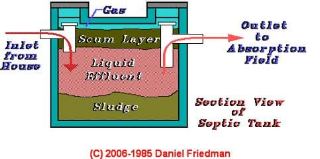
Emile,
The volume of a septic tank is calculated based on the shape of the tank - calculating the volume of a rectangular shape Vol = L x W x H or for a cylindrical shape the formula and examples are
at CALCULATE SEPTIC TANK CAPACITY - compute required septic tank capacity based on its measurements
The actual volume of wastewater in a properly-working rectangular septic tank is easier to calculate than a cylindrical one since we have to consider just the volume of the container up to the bottom of the outlet pipe.
If you want to calculate just the "liquid" volume of the septic tank you need to measure the current thickness of the floating scum layer and bottom sludge layer and thus to subtract those from the first volume that you calculated.
The "freeboard" in the septic tank has to be the volume between the bottom of the septic tank outlet pipe (assuming again a properly-working septic system with no blockages in the outlet or drainfield) and the top of the septic tank baffle or tee.
That's because any depths higher than the tee top mean that the outlet is blocked and the system is not working normally.
...
Continue reading at SEPTIC DRAINFIELD SIZE or select a topic from the closely-related articles below, or see the complete ARTICLE INDEX.
Or see SEPTIC TANK SIZE FAQs - questions & answers about septic tank size posted originally on this page.
Or see these
Septic Tank Types - Articles
- COMMERCIAL SEPTIC DESIGN
- SEPTIC DRAINFIELD LOCATION for help in finding an existing septic soakaway bed, leach field or drainfield
- SEPTIC DRAINFIELD SIZE
- SEPTIC TANK, HOW TO FIND
- SEPTIC TANKS, CONCRETE
- SEPTIC TANKS, FIBERGLASS / PLASTIC
- SEPTIC TANKS HOME MADE SITE BUILT
- SEPTIC TANK LEVELS of SEWAGE
- SEPTIC TANK PUMPING SCHEDULE
- SEPTIC TANK SIZE
- SEPTIC TANK SIZE vs SEWAGE FLOW
- SEPTIC TANKS, STEEL
Suggested citation for this web page
SEPTIC TANK SIZE at InspectApedia.com - online encyclopedia of building & environmental inspection, testing, diagnosis, repair, & problem prevention advice.
Or see this
INDEX to RELATED ARTICLES: ARTICLE INDEX to SEPTIC SYSTEMS
Or use the SEARCH BOX found below to Ask a Question or Search InspectApedia
...
Ask a Question or Search InspectApedia
Try the search box just below, or if you prefer, post a question or comment in the Comments box below and we will respond promptly.
Search the InspectApedia website
Note: appearance of your Comment below may be delayed: if your comment contains an image, web link, or text that looks to the software as if it might be a web link, your posting will appear after it has been approved by a moderator. Apologies for the delay.
Technical Reviewers & References
Click to Show or Hide Citations & References
Publisher InspectApedia.com - Daniel Friedman
Size Of Septic For 3 Bedroom House
Source: https://inspectapedia.com/septic/Septic_Tank_Size_Tables.php

0 Komentar